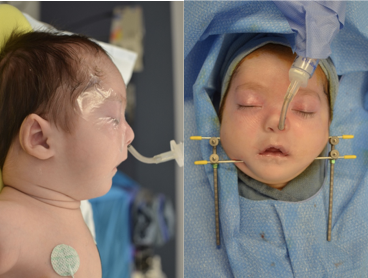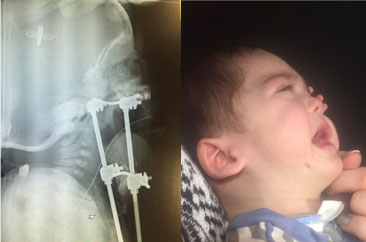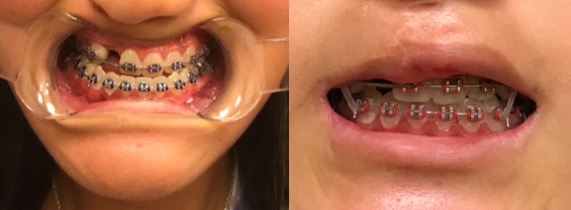Distraction osteogenesis has become the standard of care when treating severe mandibular hypoplasia leading to obstructive sleep apnea.
Syndromes associated with mandibular hypoplasia and possible OSA
- Pierre Robin Sequence
- Stickler Syndrome
- Nager Syndrome
- Treacher Collins Syndrome
- Hemifacial Microsomia
- Goldenhars Syndrome (Oculo-Auriculo-Vertebral (OAV) syndrome)
- Hemifacial Microsomia
A common syndrome that is associated with a small jaw and tongue-based obstruction (OSA) is Pierre Robin Sequence (PRS). PRS is defined as a triad of retrognathia, glossoptosis, and airway obstruction. Prevalence of this disorder ranges from 8,500 to 20,000 births per year.
A syndromic variant prevalent in as high as 50% of PRS is Sticker Syndrome. This syndrome is characterized by flattened facial appearances, vision problems (myopia, glaucoma, cataracts, and retinal detachment), and joint problems.
When the tongue is large and posteriorly placed, it may interfere with palate development leading to an isolated cleft palate frequently seen in these patients. The large and posteriorly placed tongue may also lead to respirator compromise requiring more urgent airway intervention.
If your child has airways difficulties at birth and PRS is suspected, he/she may be placed in a prone (face down) position first to help the obstruction. Historically, tongue-lip adhesion (when the tongue is sewn to the lip) was the initial treatment of choice for airway compromise.
However, now the treatment of choice is mandibular distraction osteogenesis (MDO). Timing of the surgery can be performed as a neonate at birth up to even teenage years. Performing MDO at birth is usually in an effort to prevent tracheostomy.
What can you expect following surgery?
Your surgeon may utilize two different distraction techniques. There are internal and external distractor devices. In sum, both lead to the same bone generation through advancing the osteotomized segments about 1 mm a day. The distraction period lasts usually 1-2 weeks and then the device may be left in place for a period of time to allow for bony consolidation in order to prevent bony relapse.
There may be feeding difficulties as the distraction occurs necessitating feeding tube assistance or other feeding techniques.
Here at the Kentucky Center for Cosmetic and Reconstructive Surgery, we have expertise utilizing internal distractors, 2-pin external distractors, and rigid external devices (RED) to tailor your child’s needs in improving the airway.

A patient with Sticker Syndrome. Left- preoperative, Right- postoperative.

Left- after expansion, Right- residual scarring at 3 months post operative
Maxillary Hypoplasia
Distraction osteogenesis is also used to treat severe maxillary hypoplasia.

When the upper jaw does not grow as well as the lower jaw, the upper teeth remain behind the lower teeth which is not correctable by orthodontics (Class III occlusion). When severe, this may also contribute to OSA described above and affect speech, eating, and may cause trismus or TMJ pain long term.
This clinical scenario is most often seen in cleft patients who have had multiple surgeries, complications, or excessive scarring to the lip or palate. With excessive scarring, traditional Lefort I advancement may lead to high rates of relapse and failure to maintain adequate occlusal relationship of the dentition over time.
Lefort I distraction osteogenesis is a relatively newer surgical technique to overcome problems related to relapse when the upper jaw must be moved great distances (greater than 7-8 mm).
During Lefort I distraction, the same osteotomy cuts are made as with traditional Lefort I surgery; however, the bone is advanced very slowly (1 mm a day) to overcome the restrictive scar tissue forces as well as to allow for the bone to fill in the gap naturally without bone grafting.
What to expect following surgery:
- The surgery typically takes around 2-3 hours and may involve the use of an internal or external distraction device.
- The patient usually stays in the hospital for 1-2 days and distraction performed twice daily for around one week.
- A consolidation period to allow for adequate bone generation is undertaken before the distractors are removed.
- Timing of surgery is usually over holiday break or summer to allow additional time for healing.
- A soft diet is required while the advancing bone is healing.